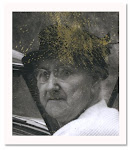 I don't find pristine tintypes. I find tintypes that are bent, and jagged, and scuffed. But somehow the rosy cheeks always manage to come through the turmoil of 100+ years. This particular image has more damage than you can imagine. Right through the horizontal middle it's severely bent. I'm actually surprised it scanned as nicely as it did.
I don't find pristine tintypes. I find tintypes that are bent, and jagged, and scuffed. But somehow the rosy cheeks always manage to come through the turmoil of 100+ years. This particular image has more damage than you can imagine. Right through the horizontal middle it's severely bent. I'm actually surprised it scanned as nicely as it did.So would you call the scratches patina? In this case patina brings down the photos value which means it's cheap enough for me to buy.
My imaginings say this fellow had this shot taken in San Francisco and that he was of Italian descent. The truth is, I have no idea. He could be a pool hustler from Poughkeepsie. Or perhaps he was in a tour group of famous faces and his job was to pretend to be Bat Masterson. Heck, almost all guys back then seem to have looked like Bat Masterson. That's the problem with these old images. Everyone looks like a cardboard cut-out.
So I give you "Cardboard Cut-Out of Man With Trees."


















That is one really busy backdrop. Looks like he is standing on canvas. I wonder if he is outside on a lawn. I know they needed a lot of bright light "back in the day".
ReplyDeleteAnd there is a special feeling when you rescue one of these from oblivion. Good work.
ReplyDeleteMy post last weekend was a mystery tintype also. I like this one. Patina is always important, just like antique furniture, but I always improve the images by adjusting for fade and contrast when I publish them on my blog. The scratches and swirls are literally the photographer's fingerprints, so those stay, but flakes and spots are the result of age and accident so I fix those.
ReplyDeleteI agree. I find, especially with tintypes, I have to adjust the levels in order to see the image. They are almost always so very dark. I want to be able to see what the photographer saw.
Delete